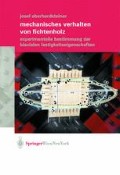Zusammenfassung
Mikroskopisch gesehen besteht der natürlich gewachsene, organische Werkstoff Holz aus einem von Zellwandsubstanz und Zellhohlräumen gebildeten porösen, inhomogenen Gefüge. Die mechanische Anisotropie von Holz wird durch den länglichen Aufbau der Zellen und die Orientierung der Zellwände sowie durch unterschiedliche Zellgrößen während einer Wachstumsperiode begründet.
Access this chapter
Tax calculation will be finalised at checkout
Purchases are for personal use only
Preview
Unable to display preview. Download preview PDF.
Author information
Authors and Affiliations
Rights and permissions
Copyright information
© 2002 Springer-Verlag Wien
About this chapter
Cite this chapter
Eberhardsteiner, J. (2002). Stand der Forschung. In: Mechanisches Verhalten von Fichtenholz. Springer, Vienna. https://doi.org/10.1007/978-3-7091-6111-1_2
Download citation
DOI: https://doi.org/10.1007/978-3-7091-6111-1_2
Publisher Name: Springer, Vienna
Print ISBN: 978-3-211-83763-4
Online ISBN: 978-3-7091-6111-1
eBook Packages: Springer Book Archive

